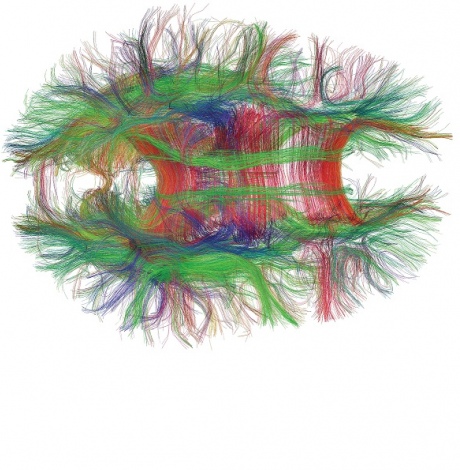

An exhibit at the Royal Society Summer Science Exhibition will test your ability to concentrate with technology used in brain injury research.
The exhibit ‘Networks in the brain’ was created by a team from the Computational, Cognitive and Clinical Neuroimaging Laboratory (C3NL) in the Department of Medicine, Imperial College London. It aims to illustrate the group’s research on brain networks in patients suffering brain injury and demonstrate various methods to measure cognitive functions such as attention and memory.
Exhibiting at the Royal Society Summer Science Exhibition is a great chance to explain our research and gain feedback on what it means to the public
– Dr Greg Scott
Clinical Research Fellow
The exhibit consists of three elements: a mind-controlled video game called ‘EEG Pong’; a series of interactive cognitive tests; and 3-D videos that demonstrate the intricacy of the connections in the white matter of the brain.
“This is the first time we are bringing all these interactive elements together,” says Dr Gregory Scott, Clinical Research Fellow in the Division of Brain Sciences . “Public engagement is important for ensuring our work remains relevant. Exhibiting at the Royal Society Summer Science Exhibition is a great chance to explain our research and gain feedback on what it means to the public.”
“Our research looks at the brain as networks of interacting regions, much like the world-wide-web or social networks,” he explains. “Brain networks are formed from multiple brain regions communicating with each other, through 100,000 miles of connections formed by white matter fibres. Different brain networks support different cognitive functions. As a group, we study people suffering damage to these connections caused by brain injury. We hope the exhibit will help visitors appreciate the complexity and delicacy of these connections and provide insight into how damage to the brain disrupts these connections.”

A section of the brain viewed from above, created with diffusion tensor imaging, showing the complex arrangement of white matter fibres that connect different brain regions
Loss of focus and attention is one of the main problems that results from traumatic brain injury and the video game aims to demonstrate how this can be monitored, with the potential to aid rehabilitation. The retro-style video game measures fluctuations in brain waves in real time with an electroencephalogram (EEG), and then uses the readings to control the game.
The device measures changes in electrical brain activity using an electrode, which is positioned on the scalp. Traditionally measurements are taken with multiple electrodes worn as a cap, but the video game uses a lightweight portable single-electrode system that rests neatly on the head. The game measures the strength of a particular brain rhythm called alpha, which is linked to mental exertion and concentration.
The measure of alpha power can be used to provide feedback on attention levels to reduce drifts in concentration experienced by brain injury patients but, in the video game, the signal is used to play EEG ping pong. The level of alpha power controls how accurately you move your bat to return the ball to your opponent.
The exhibit is set within a series of stunning panels showing the brain’s networks of interconnected regions using images created from diffusion tensor imaging, a type of scan that visualises white matter connections in the brain. There is also the opportunity to take part in several cognitive tests of attention and memory and see how you compare with the other visitors to the exhibition. Lastly there will be a series of 3-D videos that further illustrate the connections in the brain.
“The Royal Society Summer Science Exhibition is a perfect opportunity to showcase our work,” says Dr Scott.” We hope we’ve provided a combination of interaction, fun and learning to provide a valuable and entertaining experience for visitors so they come away understanding more about brain networks and their importance in brain injury.”
The Royal Society Summer Science Exhibition ‘Networks in the brain: mapping connections and measuring damage' runs from 1 to 6 July. You can follow the team on twitter on @neurosharp.
Supporters

Article text (excluding photos or graphics) © Imperial College London.
Photos and graphics subject to third party copyright used with permission or © Imperial College London.
Reporter
Franca Davenport
Communications and Public Affairs

Contact details
Email: press.office@imperial.ac.uk
Show all stories by this author




Leave a comment
Your comment may be published, displaying your name as you provide it, unless you request otherwise. Your contact details will never be published.